Physical Address
304 North Cardinal St.
Dorchester Center, MA 02124
Physical Address
304 North Cardinal St.
Dorchester Center, MA 02124
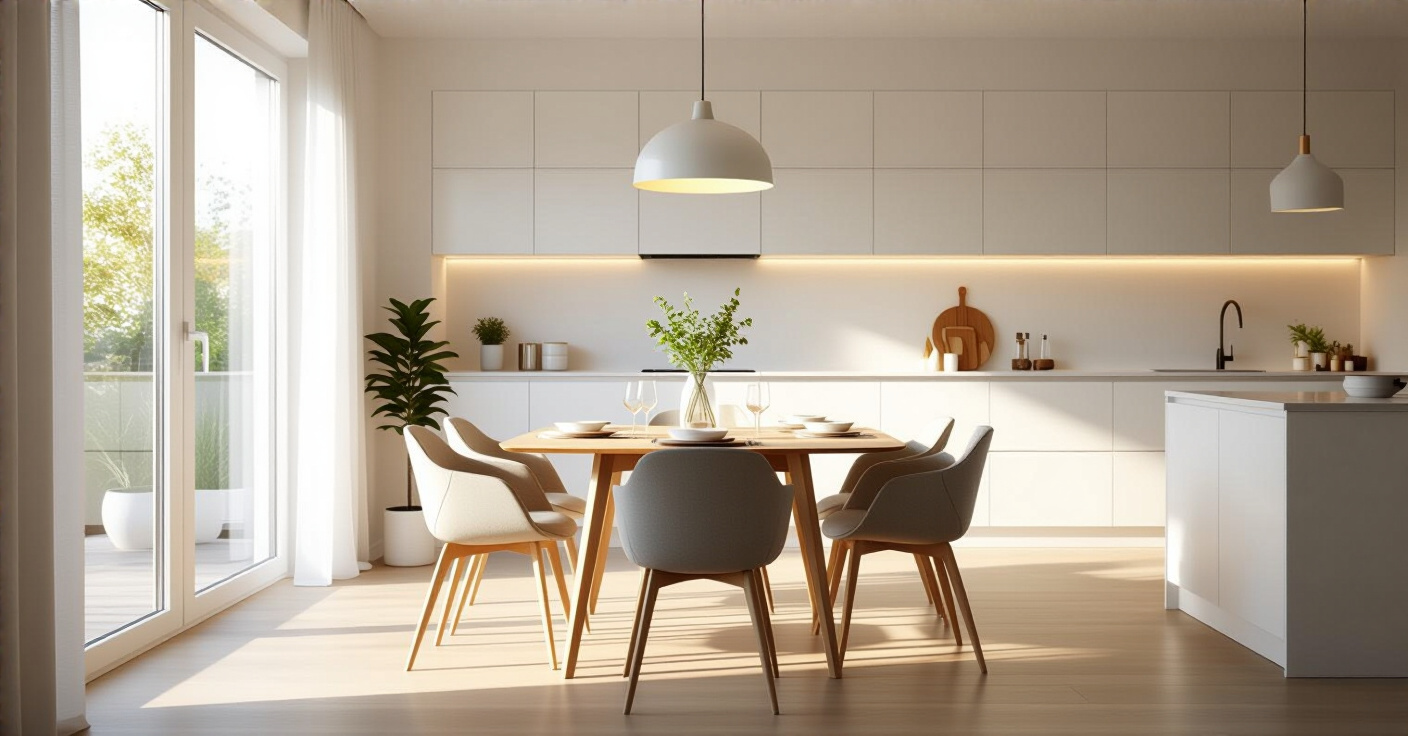
Discover 18 timeless kitchen table ideas for historic homes. Blend authentic style, durable materials, and modern function with an architect's eye.
Picture this: You’ve just bought a glorious 1920s Craftsman bungalow, the kind with those deep eaves, original built-ins, and floors that creak just so. You’re standing in the kitchen, envisioning family dinners and morning coffee. And then, the impulse hits to go online and buy a flat-packed, laminated-particleboard table because it’s fast and trendy. Can we please talk about why this is one of my biggest pet peeves? It’s like putting a plastic bumper sticker on a vintage Bentley.
A home with history has a soul. It has bones. And the pieces you bring into it should honor that story, not shout over it. The kitchen table, more than almost any other piece of furniture, is the modern heart of the home—the new hearth where life happens. Finding the right one isn’t about following trends; it’s about choosing a future heirloom. I’m here to help you cut through the noise of fleeting styles and find a table that feels like it’s always belonged, while still serving your very modern life.
Before you fall in love with a photo of a magnificent, ten-foot-long trestle table, we need to talk about the room itself. In a historic home, the space dictates the furniture—not the other way around. These older rooms were built with different proportions and purposes in mind, and respecting that is the first step to creating a kitchen that feels both authentic and functional. This isn’t just about measuring; it’s about listening to what the house is telling you.
You might think measuring is simple, but in an old house, it’s an archaeological dig. Walls bow, floors slope, and nothing is ever truly “square.” A tape measure is your best friend, but you have to use it right. Don’t just measure the middle of the room; get the dimensions near the doorways, windows, and any built-ins. You’re looking for the narrowest points your table and chairs will have to contend with. The rule of thumb is 36 inches of clearance around the table, but I say aim for 42 inches if you can—it’s the difference between shimmying sideways and walking comfortably.
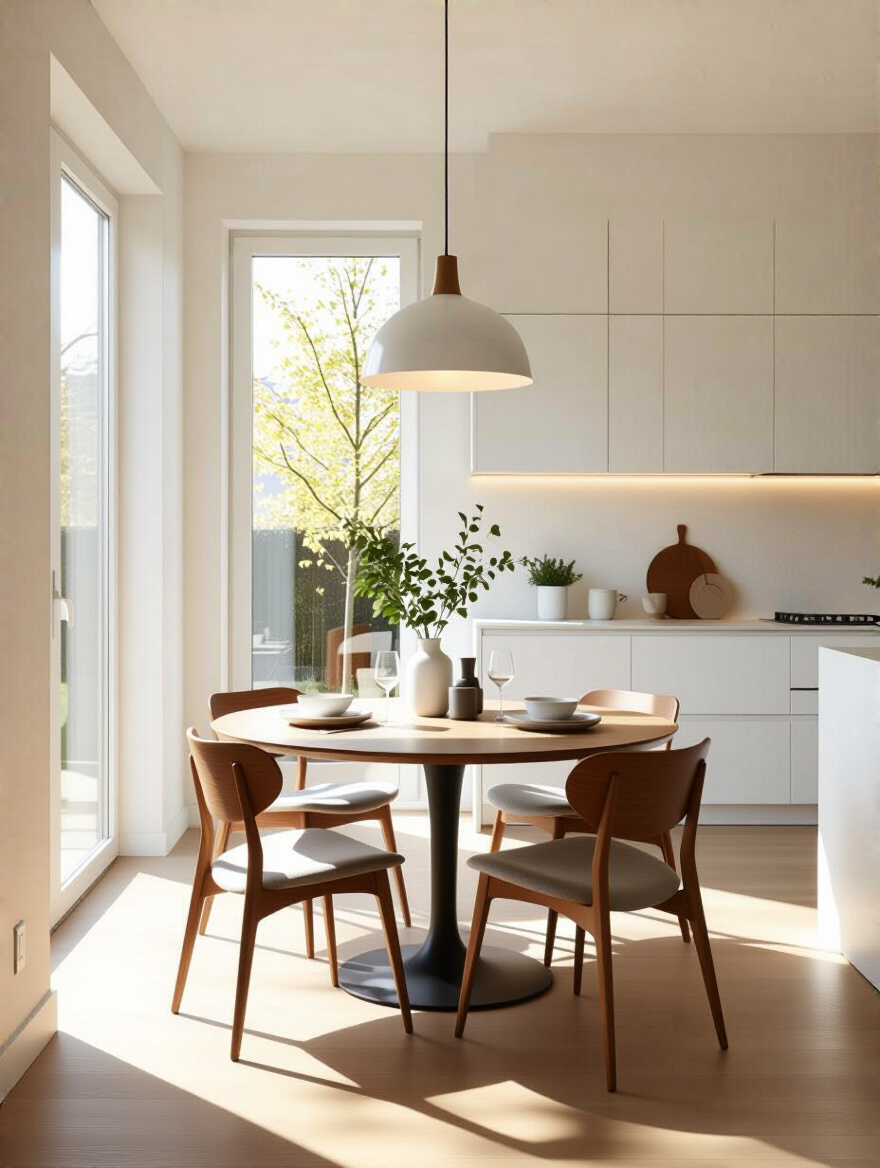
Forget eyeballing it. The best trick I know—the one I insist on with every client—is to mock it up on the floor. Use painter’s tape to outline the exact dimensions of the table you’re considering. Then, place your current chairs around it and pull them out as if you were sitting down. Can you still get to the pantry? Can you open the oven door without someone having to stand up? This simple, five-minute task has saved my clients from more expensive, heartbreaking mistakes than I can count.
A proper fit is about honoring the home’s original flow. Older kitchens were often designed as work zones, sometimes with pathways to a back staircase or a pantry. Blocking these natural “desire lines” with a table that’s too large is the quickest way to make a room feel cramped and wrong. It’s a silent battle you’ll fight every single day, so let’s get it right from the start.
Okay, so how will you really live at this table? Be honest. Is this just for breakfast before everyone scatters, or is it command central for homework, laptops, and craft projects? A historic home needs to accommodate modern life, and the table’s shape is where that negotiation begins. Don’t just buy a table because it looks nice in a showroom; buy it for the life you actually live.
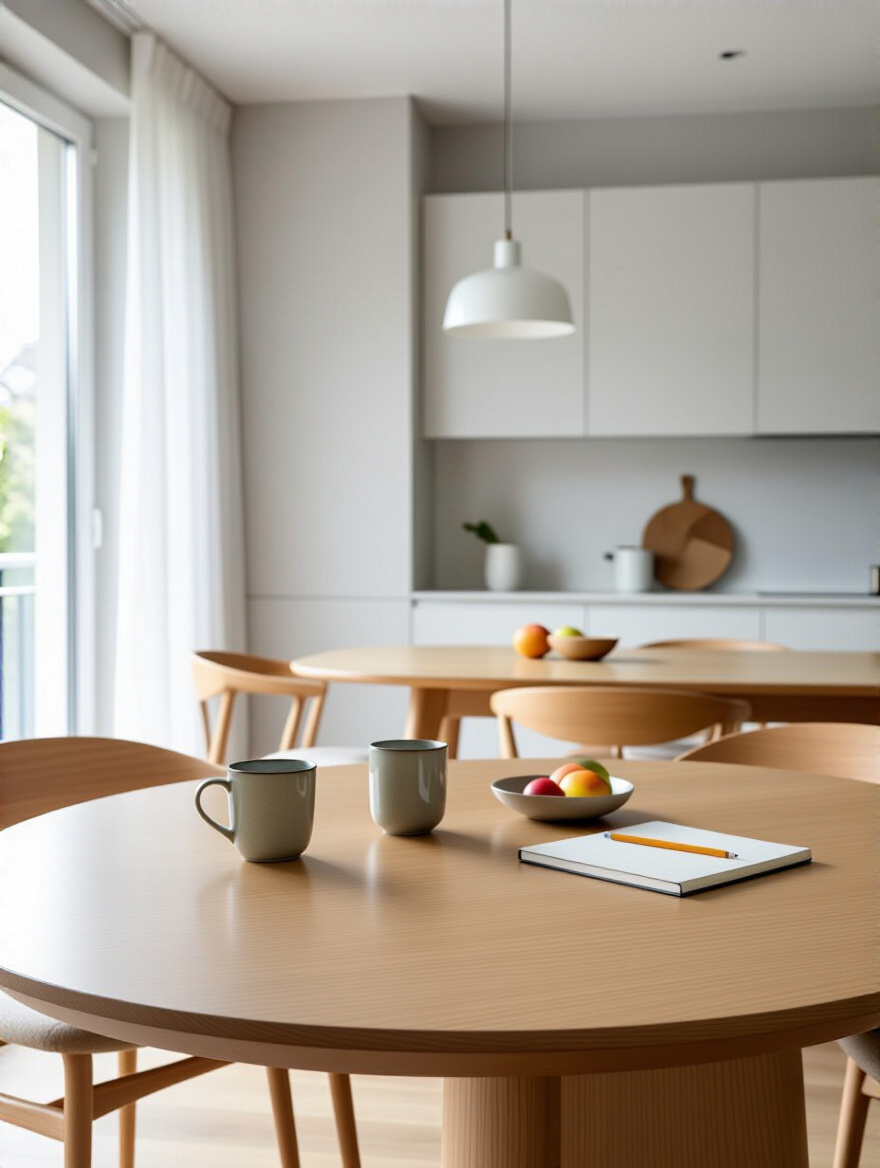
Round and oval tables are fantastic for conversation—everyone can see everyone else—and they are incredibly forgiving in tight or irregular spaces. In a square breakfast nook or a kitchen with an awkward corner, a round pedestal table is a brilliant solution because you don’t have to worry about corner legs getting in the way. Rectangular tables, the descendants of historic refectory and harvest tables, are the workhorses. They’re perfect for larger families and for creating distinct zones: homework at one end, dinner prep at the other.
Think about the story the shape tells. A long, narrow trestle table evokes a sense of communal history, of gatherings through the ages. A small, square café-style table tucked into a corner speaks of intimate mornings with a newspaper and coffee. I had a client with a beautiful Victorian kitchen who was set on a massive rectangular table. We taped it out, and it was a fortress. We switched to a large oval table, and suddenly the room could breathe. The shape softened the kitchen’s angles and improved the flow without sacrificing a single seat.
Everyone says they want to seat ten people for Thanksgiving. In reality, most of us eat with the same three or four people 360 days a year. My advice? Prioritize your daily needs. Choose a table that fits your everyday life perfectly, rather than one that feels cavernous and empty most of the time just to accommodate a few big gatherings. Your home should serve you, not your once-a-year guests.
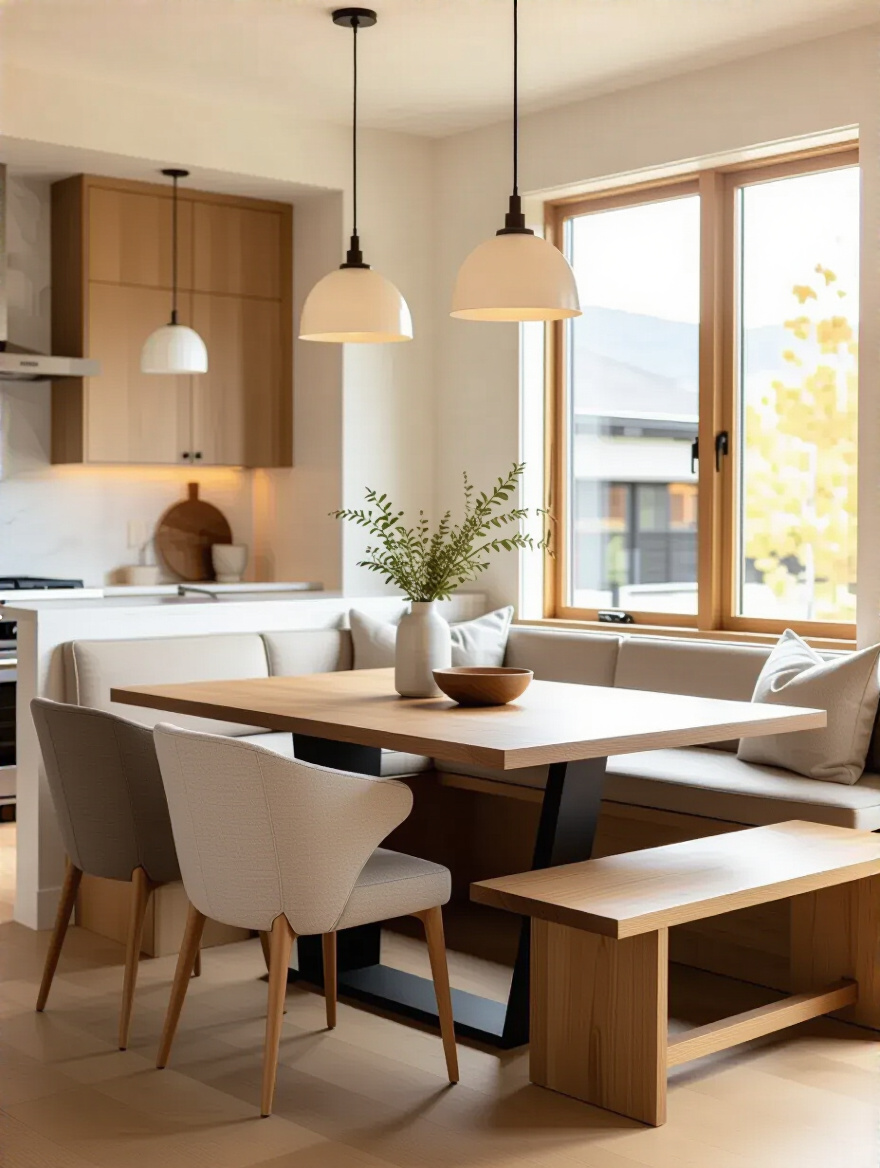
The gold standard for comfort is allowing 24 inches of table edge per person. Anything less and you’ll be knocking elbows. A bench is a fantastic, historically-rooted solution for squeezing in more people, especially children, without adding the visual clutter of more chairs. It can be pushed under the table when not in use, which is a lifesaver in a smaller historic kitchen. This isn’t a new idea; think of the settles and benches that lined the walls of old keeping rooms.
For those rare, larger gatherings, the answer isn’t a bigger table—it’s a smarter one. An extendable table, particularly one with a traditional draw-leaf mechanism, is the perfect marriage of historical ingenuity and modern necessity. You get a compact, beautifully proportioned table for daily use, with the flexibility to expand when the whole family descends. This is a far more elegant solution than letting a massive table dominate a room built on a more human scale.
Let’s get this out of the way: a good table is an investment. The mass-produced furniture world has convinced us that tables should be cheap and disposable, and that’s just nonsense. In a home built to last for centuries, you want a table that can do the same. This doesn’t mean you have to spend a fortune, but it does mean prioritizing craftsmanship over a low price tag. “Buy it once, buy it right” is my motto.
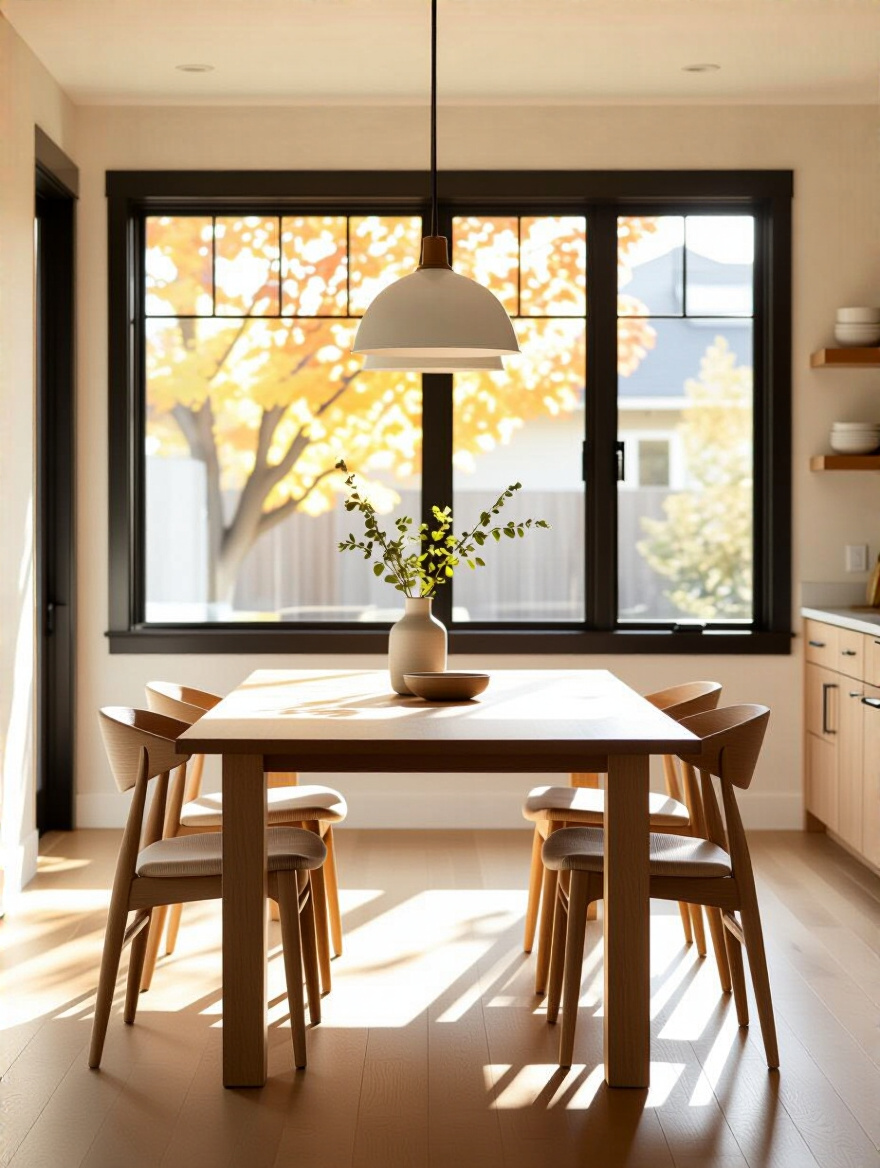
Your budget should be focused on materials. Solid wood is always the goal. It can be sanded, refinished, and repaired for generations. A table with a thin wood veneer over particle board, on the other hand, is a ticking time bomb. One deep scratch or moisture ring and it’s ruined forever. Think about where you can find that quality for less. Estate sales, antique shops, and local craftspeople are your best friends here. You can often find a century-old solid oak or mahogany table for a fraction of the cost of a new, poorly made piece.
And don’t forget the hidden costs. The price on the tag is rarely the final number. You need to factor in shipping—which can be substantial for a heavy, solid wood piece—and the cost of chairs. People often find their dream table, only to realize they’ve spent their entire budget and have nowhere to sit. A smart budget allocates money for the whole package, ensuring the final result feels complete and intentional.
We’ve covered the room’s physical footprint, but now we need to talk about the human element. How does your body fit into the space? Old homes weren’t built with modern ergonomic standards in mind. Chairs were often straighter, tables sometimes a bit taller or shorter. While we want to respect the home’s character, we also need to live in it comfortably. Finding that balance is the key to creating a space you’ll love to use every day.
The number one reason a dining setup feels “off” is almost always the height relationship between the table and the chairs. The standard today is a 29- to 30-inch-high table and an 18-inch-high chair seat. This gives you that crucial 11 to 12 inches of thigh clearance. But if you’re sourcing an antique table or chairs, these numbers can be all over the place. I once worked on a beautiful 18th-century farmhouse where the original dining chairs had seats barely 16 inches off the ground.
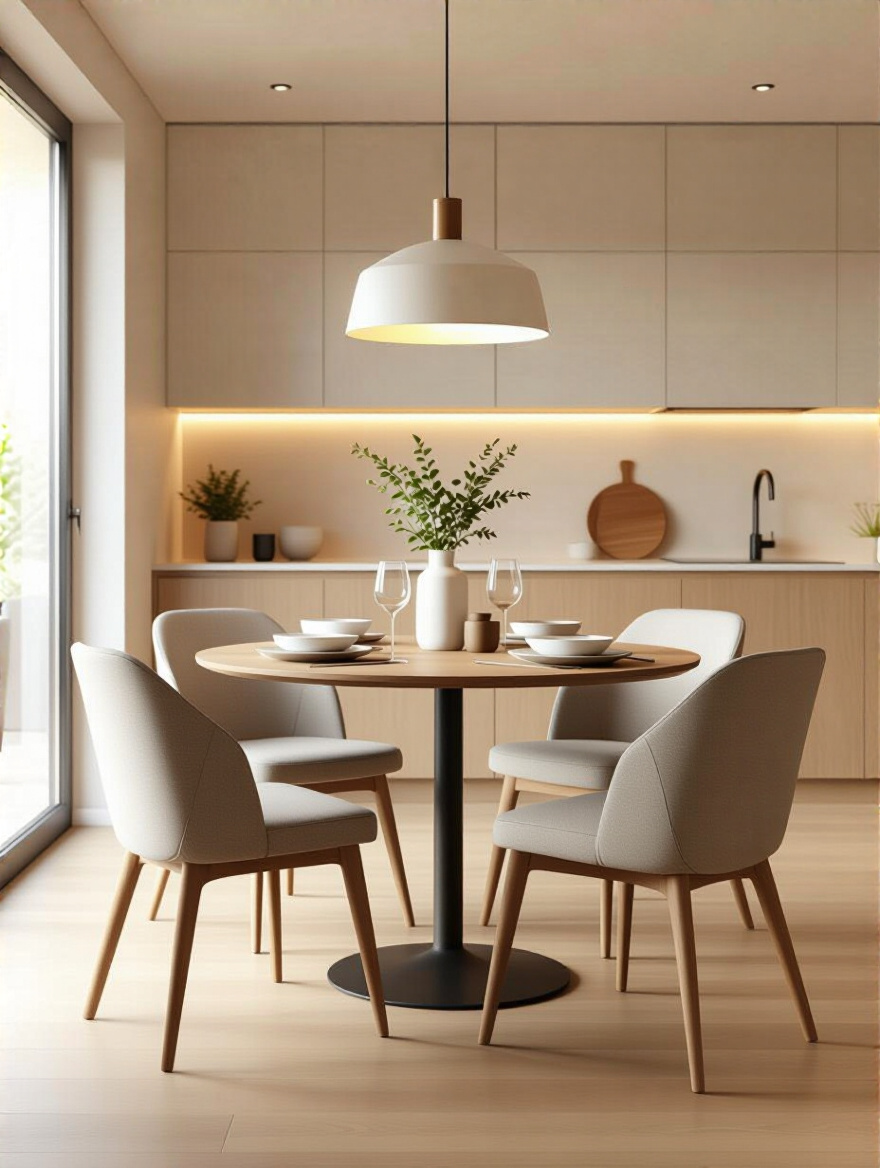
Don’t buy a table and chairs separately online without testing them out—or at least confirming their measurements. That antique “farmhouse” table might actually be a lower worktable, and modern chairs will make you feel like your chin is on your plate. Conversely, pairing low antique chairs with a modern table will leave you feeling like a child. The “Rule of 12 Inches” is your shortcut: the distance from the top of the chair seat to the top of the table should be around 12 inches for maximum comfort.
And don’t forget the table’s apron—that wooden panel just below the tabletop. This is the unseen villain of dining comfort. A table can be the perfect height, but if it has a deep apron, you’ll be banging your knees every time you sit down or try to cross your legs. This is especially true with older tables that have a drawer built into the apron. Always, always sit at a table before you buy it, and check that apron clearance.
Now for the best part: choosing the piece itself. This is where we talk about the soul of the table—the materials that give it life and the design that gives it form. A table in a historic home should have character and substance. It should feel like it has its own story, one that will now merge with yours. We’re looking for materials that age gracefully and construction that speaks of true craftsmanship.
We touched on shape for function, but now let’s talk about shape for feeling. The geometry of your table dramatically influences the energy of your kitchen. A round table is inherently democratic and communal. There’s no head of the table, making it perfect for lively family discussions and game nights. It pulls people in. Its soft edges are also a gift in high-traffic areas, preventing bruised hips as you navigate a busy kitchen.
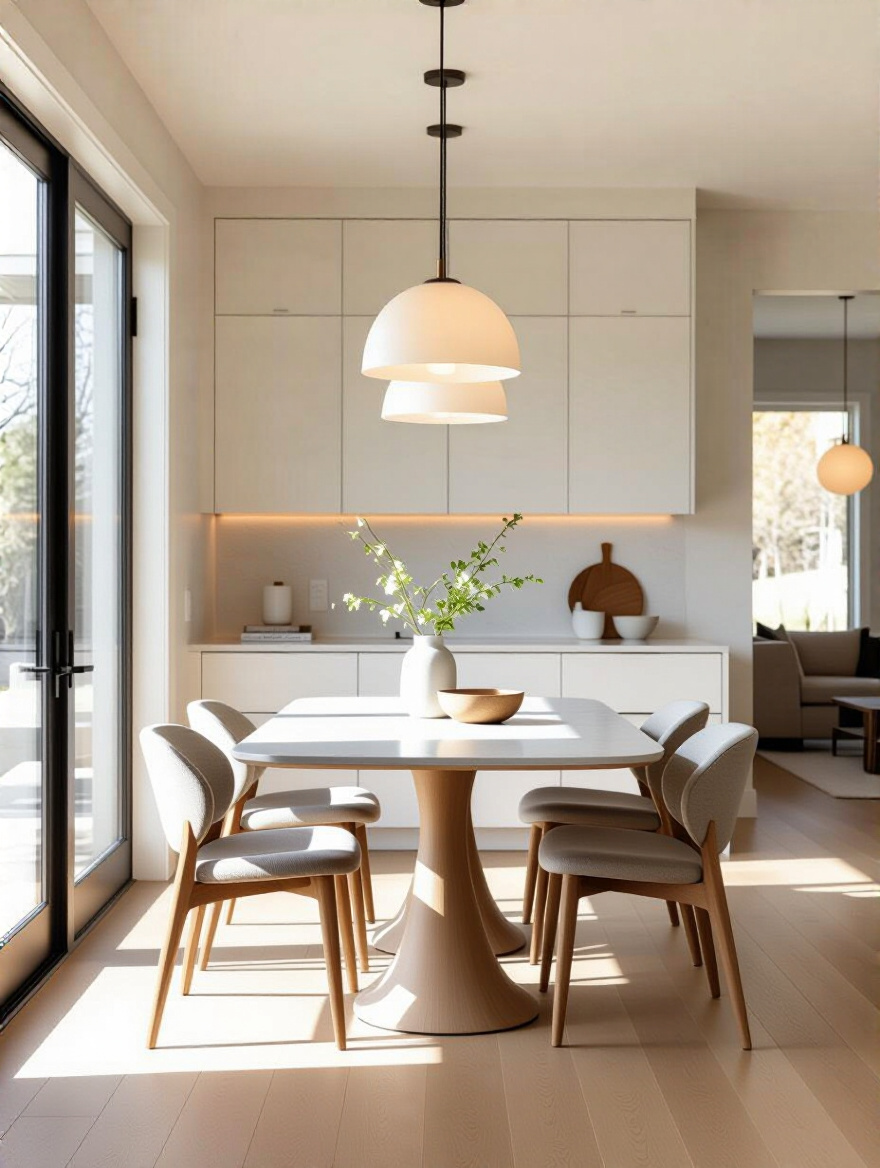
A rectangular table creates a more formal, linear path. It directs the eye and can beautifully echo the long lines of a galley kitchen or the shape of a bay window. This is the classic shape for a reason—it’s efficient and familiar. But in a historic home, consider a trestle base. By removing the four corner legs, you make it much easier to slide in and out and can often fit an extra person on each side. It’s a small change that makes a huge difference in day-to-day use.
Oval tables are the diplomats of the furniture world. They give you the linear length of a rectangle but with the softened, more inclusive feeling of a round table. I often recommend them for rooms that are long but not especially wide, as they provide generous seating without feeling like a monolithic block. They encourage flow around them, which is a blessing in the sometimes-awkward layouts of older homes.
This is where I get passionate. Please, step away from the particleboard. The materials of your table should speak the same language as your home. Think solid wood—oak, walnut, cherry, or even humble reclaimed pine. Wood tells a story. Every knot and grain pattern is unique, and it develops a beautiful patina over time with nicks and scratches that map out the life of your family. An oil finish, rather than a thick polyurethane one, is often best as it’s easy to repair and feels more authentic to the touch.
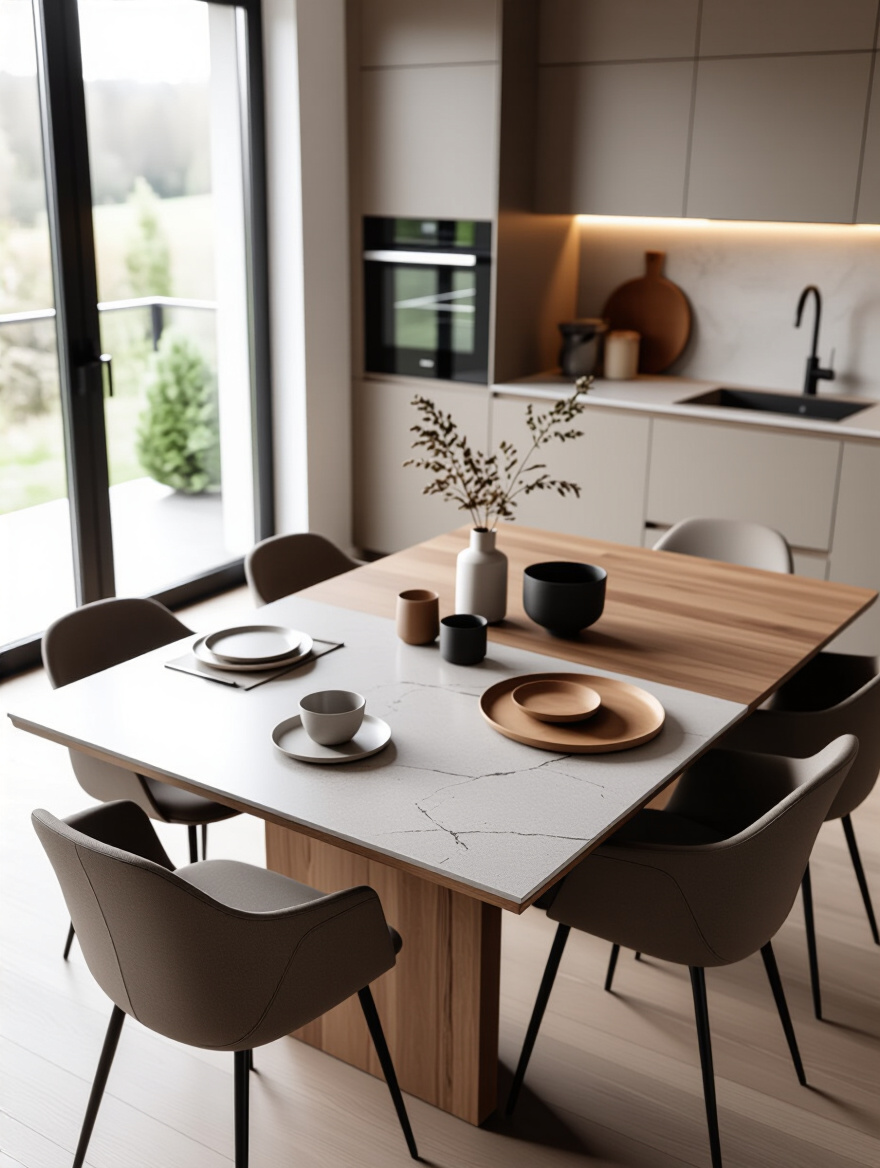
But wood isn’t the only option. Think about the historical context. Soapstone, marble, or slate tops were common on worktables in the 19th and early 20th centuries. Yes, marble will etch and stain—but that’s part of its charm! It’s called a patina, and it shows the piece has been loved and used. A zinc or copper-topped table can evoke the feel of an old scullery or bakehouse and will develop the most incredible character over time.
“Don’t be afraid of materials that show their age. A home with history isn’t a museum; it’s a living space. A few water rings on a solid wood table or an etch mark on a marble top are signs of life, not flaws.”
The absolute worst thing you can do is choose a material that’s trying to be something it’s not—like a laminate printed to look like wood. It’s a visual lie, and it will always feel cheap and hollow in a home that values authenticity. Choose honest materials, and they will reward you for decades.
The legs are the table’s architecture. They define its style and provide its strength, and they should be in conversation with the architectural details of your home. A heavy trestle base, with its visible joinery, is a perfect match for the exposed beams and sturdy construction of a Tudor, Arts & Crafts, or rustic farmhouse. It’s a design that celebrates how things are put together.
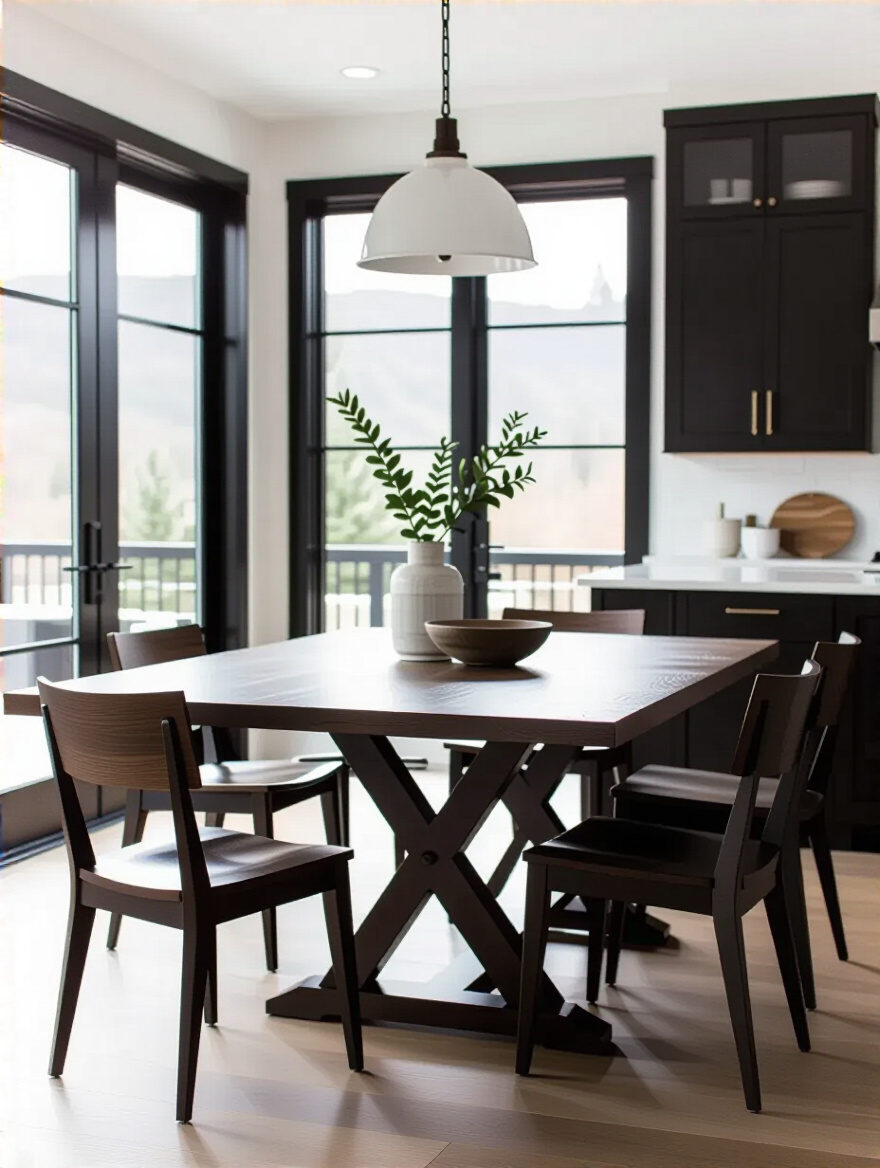
For more refined homes, like a Federal or Georgian Colonial, look for gracefully turned or tapered legs. These styles speak to an era of classicism and fine cabinetry. A pedestal base, particularly the “tulip” style or a heavier, carved column, is wonderful for Victorian and Edwardian homes and, as we’ve discussed, is a powerhouse of functionality for maximizing legroom and seating around a round or oval top.
Stability is non-negotiable. Give the table a good shove. Does it wobble? A wobbly table is not only annoying but also a sign of poor construction or joinery that’s failing. Look for quality details like mortise-and-tenon joints rather than simple screws. And consider the floor. Old houses have uneven floors. Legs with adjustable glides can be a modern lifesaver, allowing you to level the table and eliminate that infuriating wobble for good.
The extendable table is not a modern invention. For centuries, craftsmen have been devising clever ways to make tables grow to accommodate guests. One of the most beautiful and traditional forms is the draw-leaf table, where the leaves pull out from under the ends of the main top. It’s a simple, elegant mechanism that has stood the test of time.
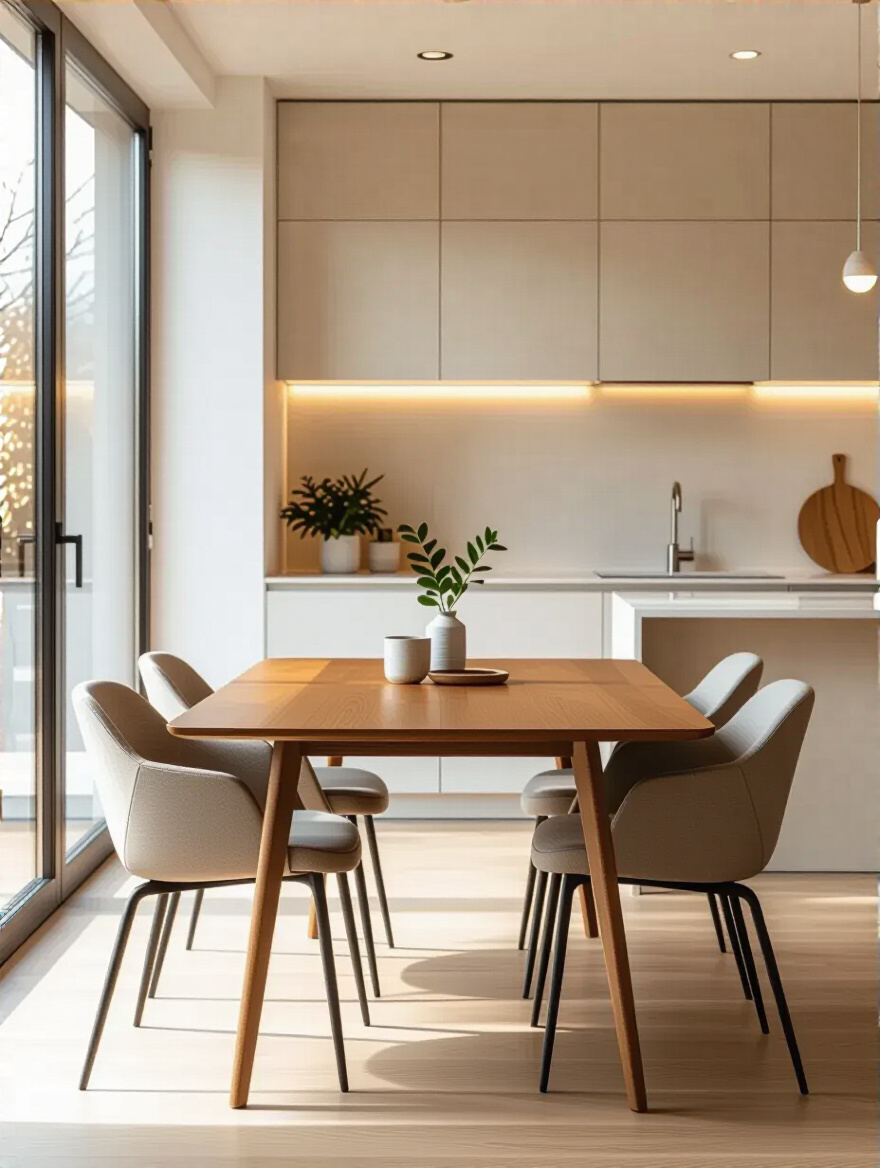
When you’re looking at modern extension tables, pay close attention to the mechanism. Does it glide smoothly, or does it feel clunky and cheap? The best modern invention is the butterfly leaf, which folds and stores itself right inside the table. This is a game-changer because you never have to wonder where you put the extension leaves from last Thanksgiving. It’s a seamless blend of contemporary convenience and timeless hospitality.
No matter the mechanism, make sure to check two things. First, when the table is extended, does the base also widen or provide enough support? A common flaw is that the extended ends have no leg support, leaving guests to straddle a single post. Second, look at the wood grain on the leaves. A high-quality table will have leaves cut from the same slab of wood as the top, so the grain matches continuously when it’s extended. It’s a small detail that signals superior craftsmanship.
We’ve covered the big picture—the shape, the bones, the material. Now, let’s refine the details. These are the elements that elevate a good table to a great one. The finish, the hidden functions, and the final check on sizing are what ensure your table doesn’t just fit in your kitchen, but that it truly belongs there, working in perfect harmony with the space and your life.
Matching doesn’t mean duplicating. I see this all the time: a homeowner with honey-oak cabinets from the 1980s feels they must buy a honey-oak table. The result is a monotonous sea of orange-toned wood. Harmony is about creating a pleasing relationship between elements, and often, that comes from complementary contrast, not from perfect matching.
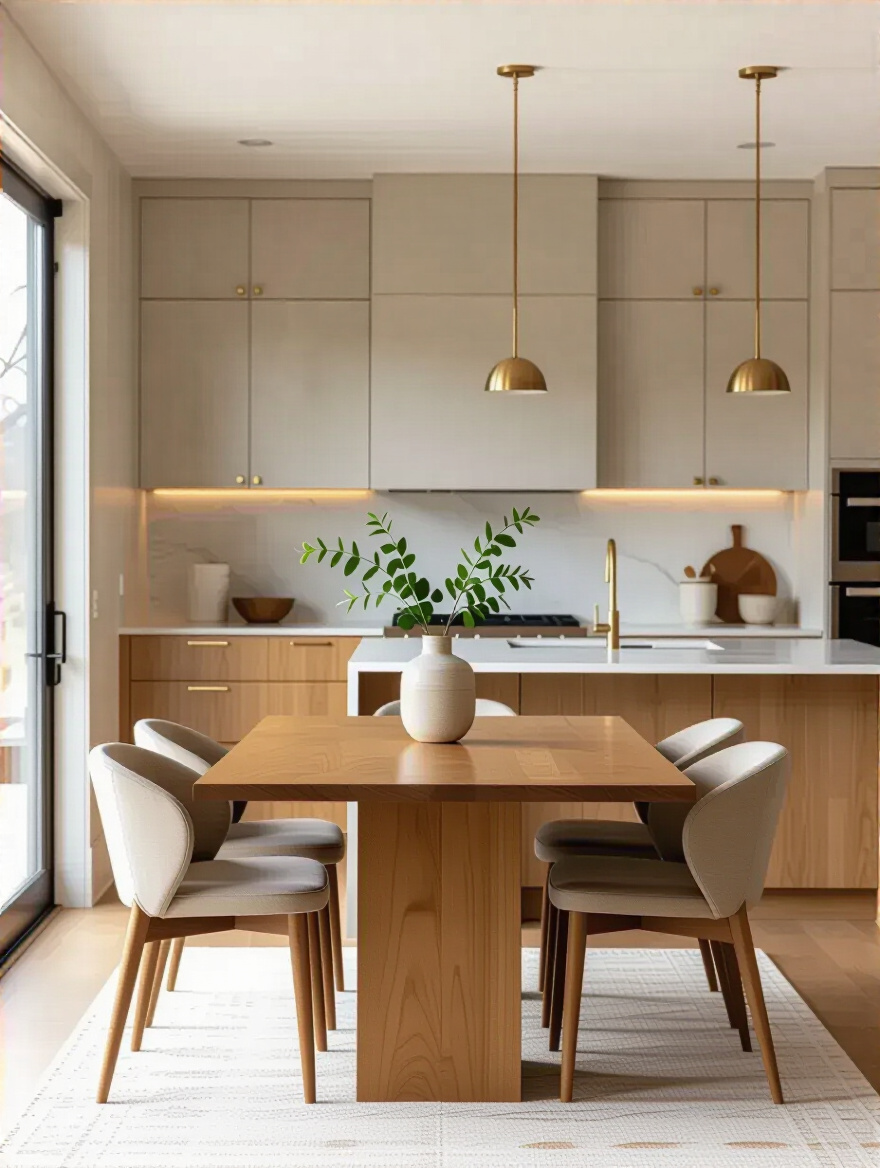
Look at the undertones in your existing wood. Is your flooring a cool-toned, ashy brown? Then a warm, red-toned cherry table might clash. Instead, look for a table in a similar cool-toned family, like walnut, or create intentional contrast with a painted finish. A black or dark green painted base with a natural wood top can be a stunning way to ground a space and connect to other colors in the room, like soapstone counters or a tile backsplash.
The goal is to create a cohesive palette. Take a sample of your cabinet wood, a photo of your floor, and a swatch of your wall color with you when you’re shopping. Look at them all together under different lights. The finish you choose should feel like it belongs in that family of colors and textures. It should be a thoughtful addition, not a random one. Remember, you are curating the story of your home, and every piece plays a part.
Storage is a modern obsession born of modern clutter. While historic kitchens often had vast pantries, our main kitchen spaces now have to work much harder. Integrating storage into the table itself can be a brilliant way to add function, but it must be done thoughtfully to avoid looking clunky or out of place. The most authentic solution is the simplest: a small drawer in the apron of the table.
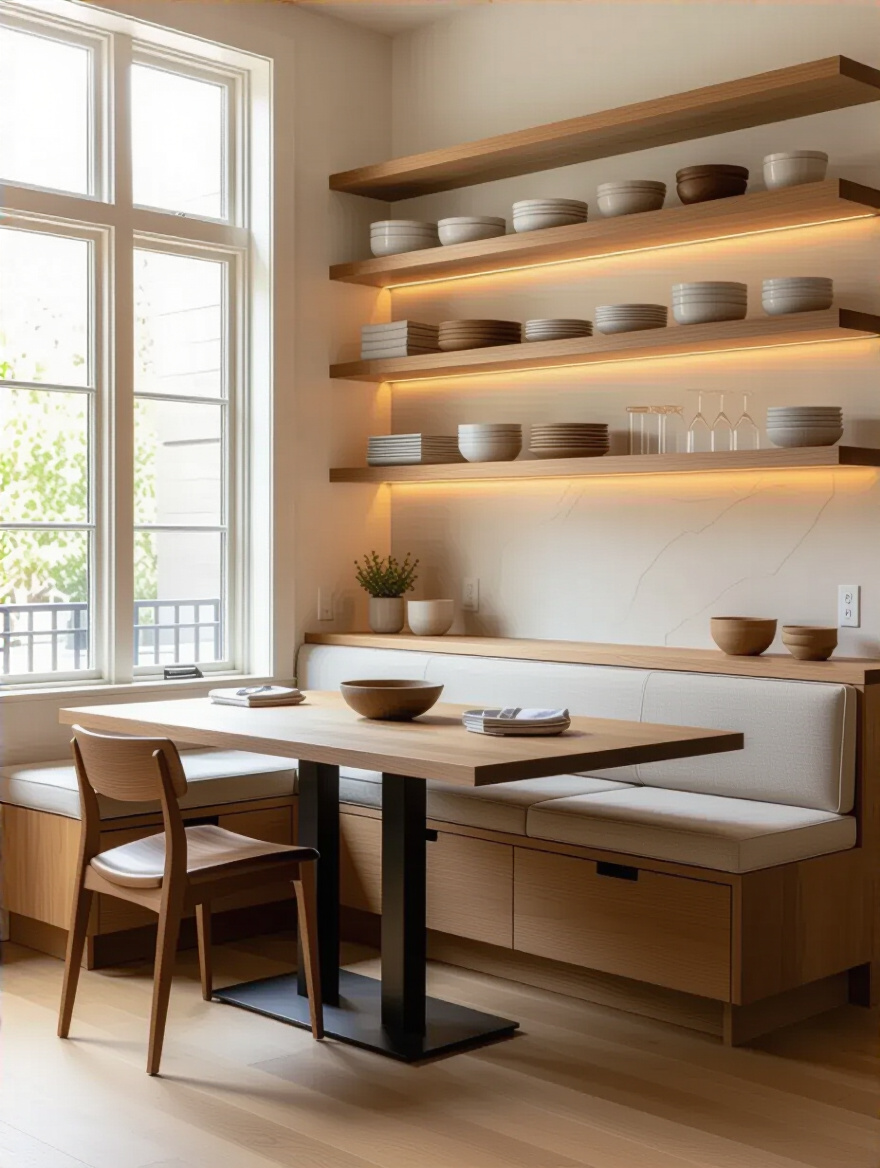
This is a feature found on worktables for centuries, perfect for storing silverware, napkins, or candles. For a more substantial solution, consider a kitchen island with seating on one side and cabinets or open shelving on the other. This creates a functional, hard-working core for the room. A freestanding “baker’s table” with a pot rack below is another historically-inspired option that provides storage without feeling heavy.
What I would caution against are overly complex modern tables with tons of hidden compartments and cubbies. They often feel gimmicky and are a nightmare to clean. Instead, think about pairing your simple, beautiful table with a freestanding piece like a small Welsh dresser or hutch. This allows you to add necessary storage while letting the table retain its elegant simplicity, which is often more in keeping with the spirit of an older home.
This is my final plea. Before you swipe your card or click “buy,” you must check the access route. I have a horror story about a client who bought a breathtaking, single-slab antique butcher block table for their Victorian townhouse. It was perfect. The only problem? They couldn’t get it through the front door, the back door, or any of the windows. Doorways in old homes are narrower. Hallways take sharp, unforgiving turns. Staircases are steep.
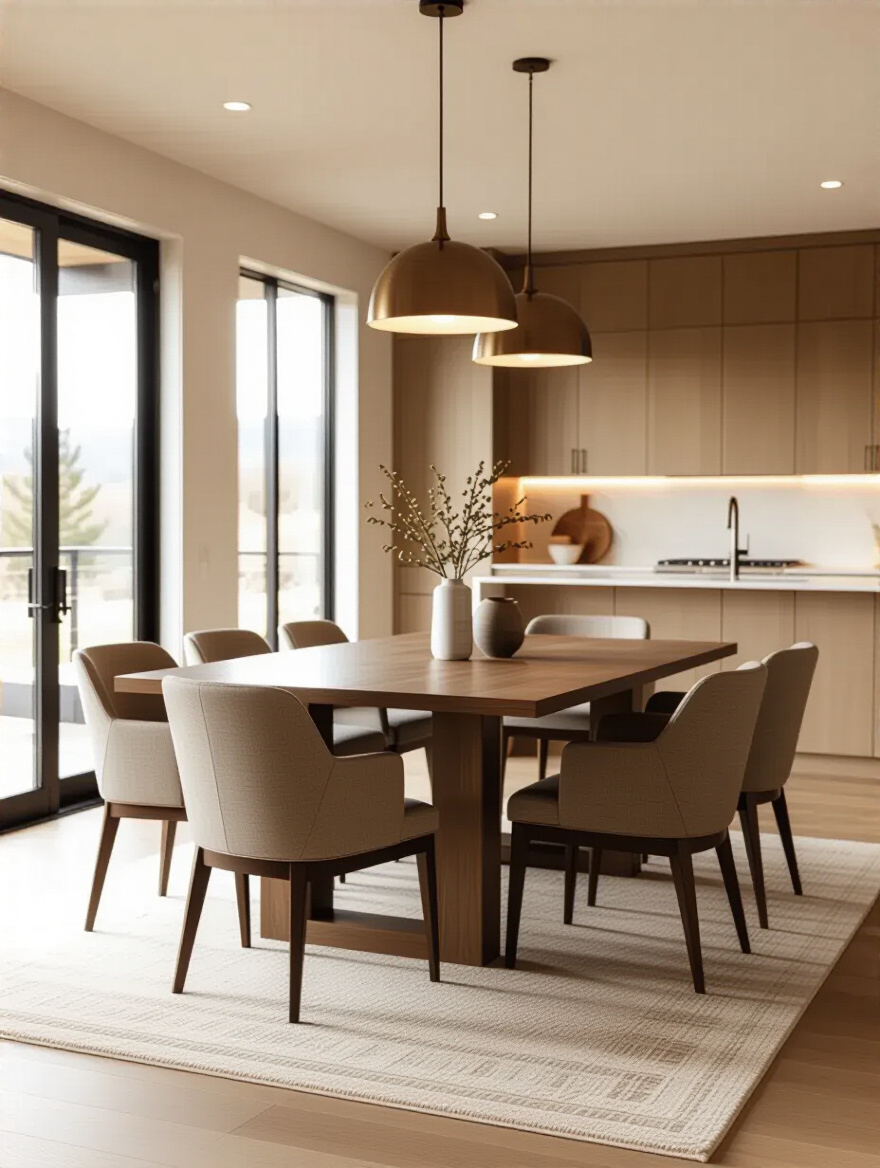
Measure every doorway, every tight corner, and every landing from the street to your kitchen. Write it all down. Then, compare those measurements to the dimensions of the table. And here’s the trick: you need the diagonal measurement of the table, too, because you’ll likely have to tilt it to get it through a door. Don’t trust a delivery company to figure it out; you are the steward of your home, and it’s your job to ensure your new treasure can actually get inside without damaging the table or the historic doorframes.
This goes for scale, too. A table that fits dimensionally might still feel wrong if its “visual weight” is off. A very thick, chunky table can overwhelm a small room with delicate trim work. Conversely, a spindly, delicate table can get lost in a large, grand kitchen with high ceilings. Step back and consider the overall proportions. Your table shouldn’t be a bully, nor should it be a wallflower. It should feel perfectly at home.
You’ve chosen the perfect table. It’s in the room, and it fits beautifully. Now, we bring it to life. This isn’t about loading it up with trendy decorations. It’s about the supporting cast—the chairs, the lighting, and the simple, useful objects that make the table a joy to be around. These elements should be chosen with the same care and respect for your home’s history as the table itself.
Please, I beg you, do not buy the matching “5-piece dining set.” Nothing screams “lack of imagination” more than a perfectly matched set. The most soulful, interesting rooms mix and match seating. It adds character and looks as though the collection has been thoughtfully assembled over time, which is the perfect vibe for a historic home.
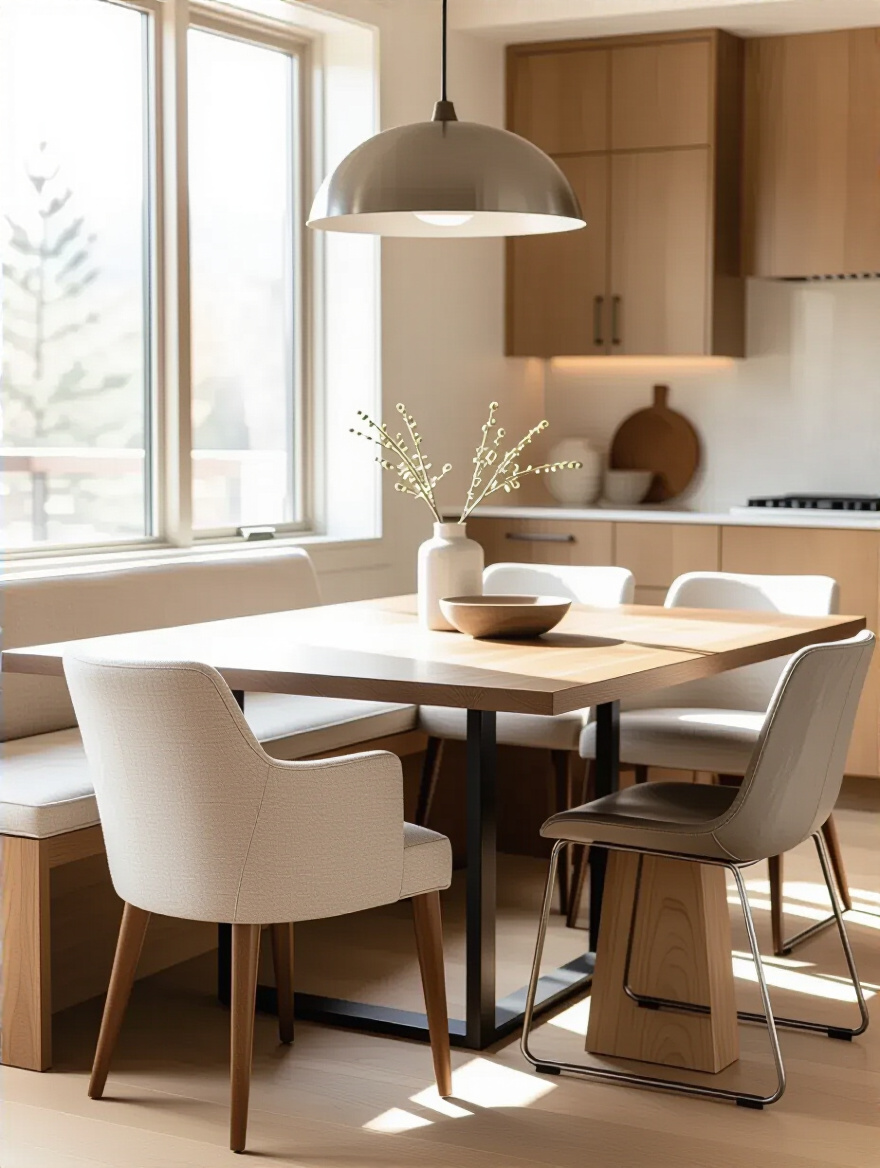
The key to a successful mix is to have one unifying element. Maybe all the chairs are the same style—like classic Windsor chairs—but they’re painted in different, complementary colors. Or perhaps the chairs are all different styles—a captain’s chair, a few ladder-backs, a wicker chair—but they are all painted the same shade of black to create cohesion. Another approach is to keep all the chairs in the same wood tone, even if their styles vary.
Most importantly, the chairs must be comfortable. The most beautiful chair in the world is useless if no one wants to sit in it. Look for chairs with a well-shaped back for support and a comfortable seat. I love pairing a sturdy farm table with upholstered host chairs at the ends. This adds a touch of softness and invites people to linger long after the meal is over, turning your kitchen table into a true gathering place.
The lighting over your table sets the mood for the entire room. In a historic home, this is a prime opportunity to either restore a period fixture or choose a reproduction that honors the era of your house. A simple schoolhouse pendant is perfect for a 1920s or 30s kitchen. A fixture with shades of milk glass can feel right at home in a Victorian. An iron or copper chandelier might be the perfect complement to a rustic, Colonial-era space.
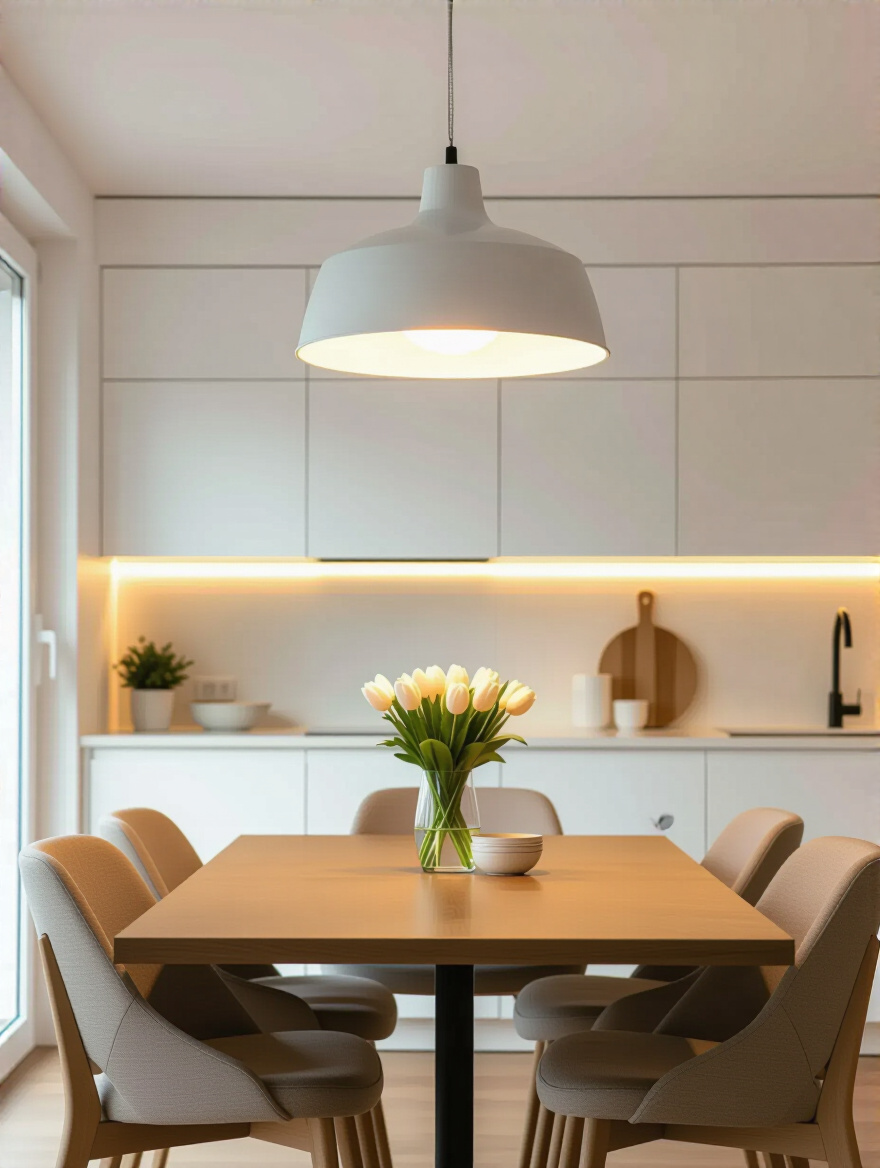
The crucial part is hanging it at the right height. A fixture hung too high feels disconnected and illuminates the whole room instead of the table. Hung too low, and it blocks sightlines and creates glare. The bottom of the fixture should hang 30-36 inches above the tabletop. This creates an intimate pool of light that defines the dining space and makes it feel cozy and inviting.
And the single most important thing you can do is put your light on a dimmer switch. This is non-negotiable. It allows you to have bright, clear light for tasks like homework or cooking prep, and then dial it down to a warm, soft glow for a relaxing dinner. It’s a simple, inexpensive update from an electrician that gives you complete control over the atmosphere of the most important spot in your house.
Less is always more, especially on a table you use every day. Your “centerpiece” should be something that is either beautiful and simple or genuinely useful. A classic ironstone pitcher filled with branches from your yard, a simple wooden bowl holding fruit for snacking, or a small crock of wooden spoons—these things add life without adding clutter.
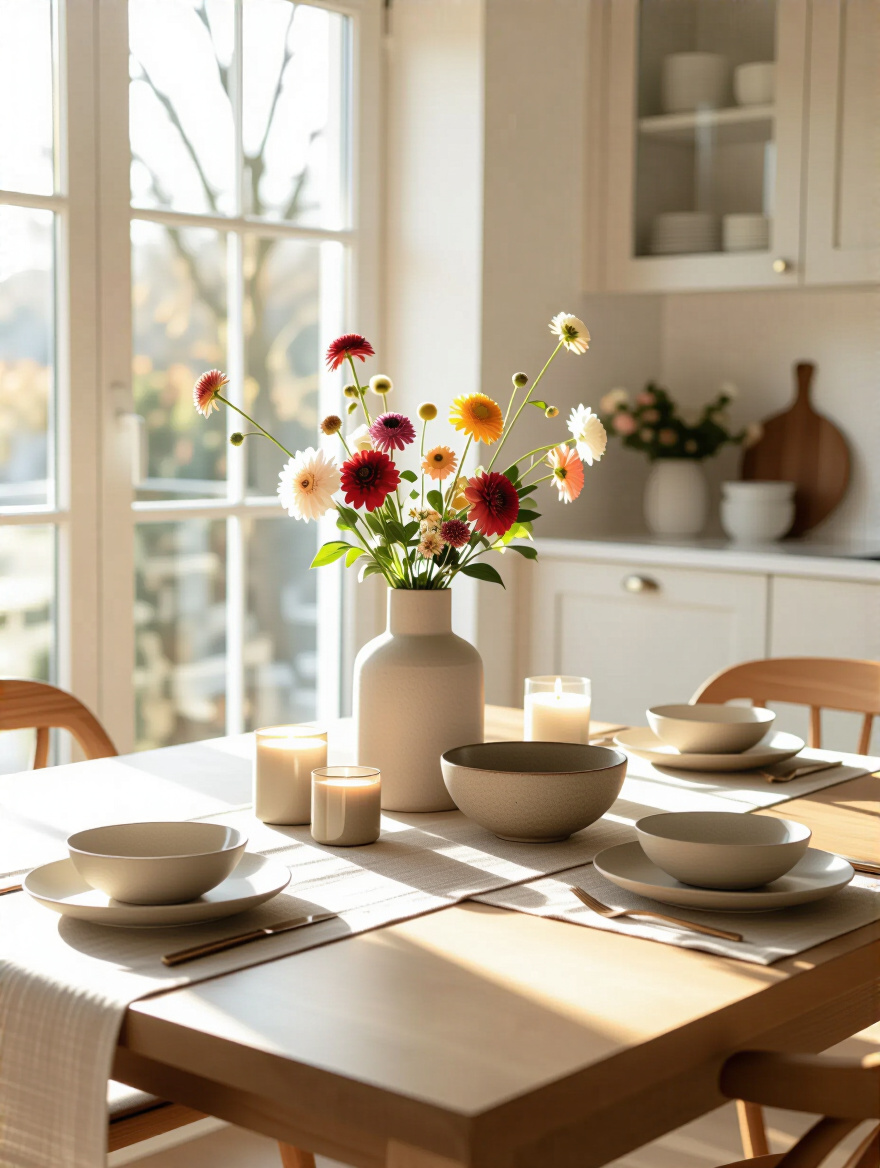
Avoid tall arrangements that block conversation or anything so precious you have to move it every time you want to set the table. The goal is effortless charm. I love using natural, seasonal elements. A small bowl of acorns in the fall, a few sprigs of evergreen in the winter, a single daffodil in a bud vase in the spring. These small gestures connect your home to the world outside its walls and celebrate the passing of time.
Linens are also your friend. A simple linen or cotton runner adds a layer of texture and softness, and protects the wood surface. Keep it simple and natural. Think materials that feel honest and hardworking, just like your table and your historic kitchen. These aren’t fussy decorations; they are the tools of a well-loved and well-used home.
Accessories should serve a purpose beyond just looking nice. In a historic kitchen, every object should feel like it has a reason for being. Instead of a purely decorative bowl, use a beautiful ceramic one to hold salt and pepper cellars. Instead of a plastic spoon rest, use a small antique ironstone plate. Think about items that combine beauty with utility.
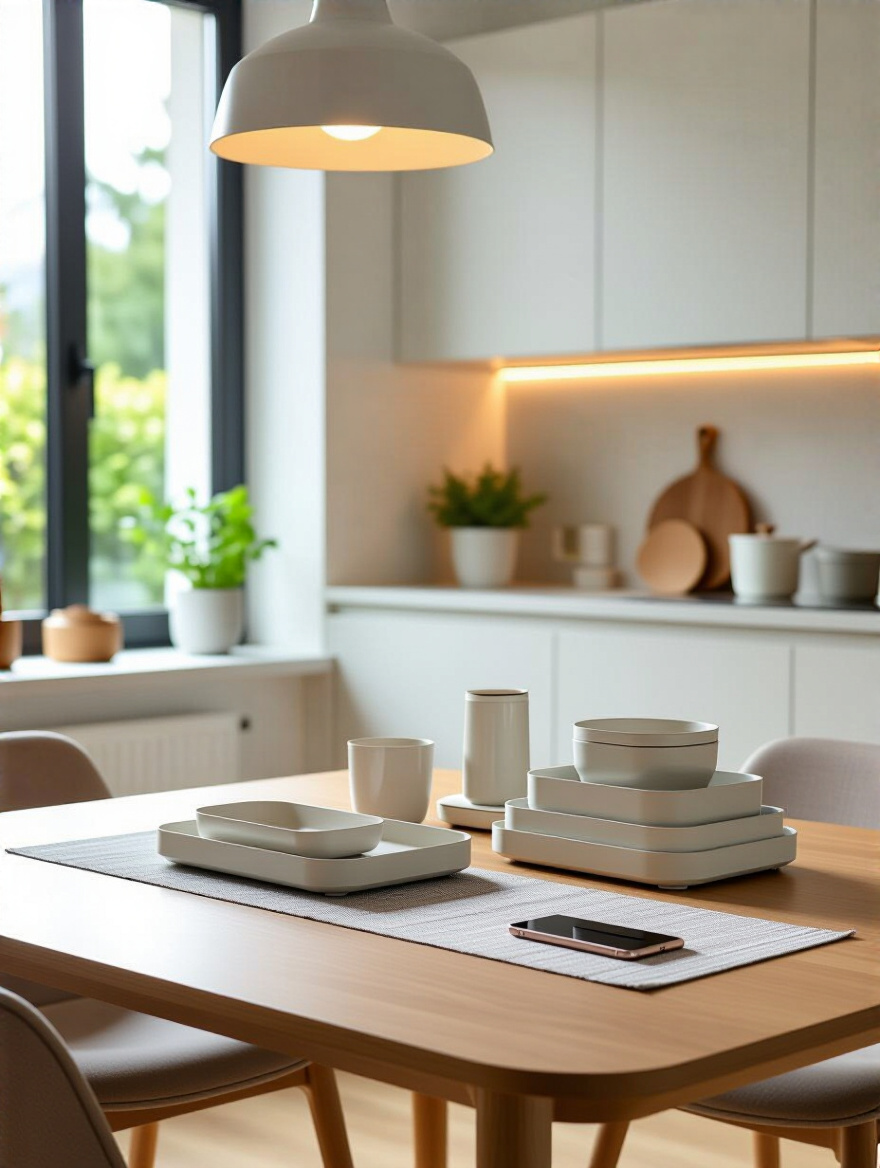
A lazy Susan, or a turntable, can be an incredibly functional addition to a round or square table. It allows everyone to easily reach condiments, napkins, or shared dishes without having to ask for things to be passed. Look for one made of a material that complements your table, like slate or a beautiful solid wood. This is a simple machine that makes communal dining more gracious.
And think vertically. A tiered stand, like those used for afternoon tea, can be a great way to corral things on a table without taking up too much surface area. Use it to hold fruit, small bowls of snacks, or even mail. It keeps clutter contained and adds a bit of architectural interest to your tabletop, freeing up precious space for plates and elbows.
A table made of honest, quality materials is not a delicate flower, but it does deserve care. This isn’t about neurotic obsession; it’s about simple, regular habits that will preserve your investment and allow the table to age gracefully. Think of it as a partnership. You care for the table, and it will serve your family faithfully for generations to come, collecting memories and stories in its very grain.
The most important rule of table care is to wipe up spills immediately, especially on a solid wood table. A damp cloth is all you need for daily wipe-downs. Avoid harsh, all-purpose chemical cleaners, which can strip the protective finish from your table over time, leaving it dull and vulnerable. For a deeper clean, a tiny drop of mild dish soap in warm water is sufficient.
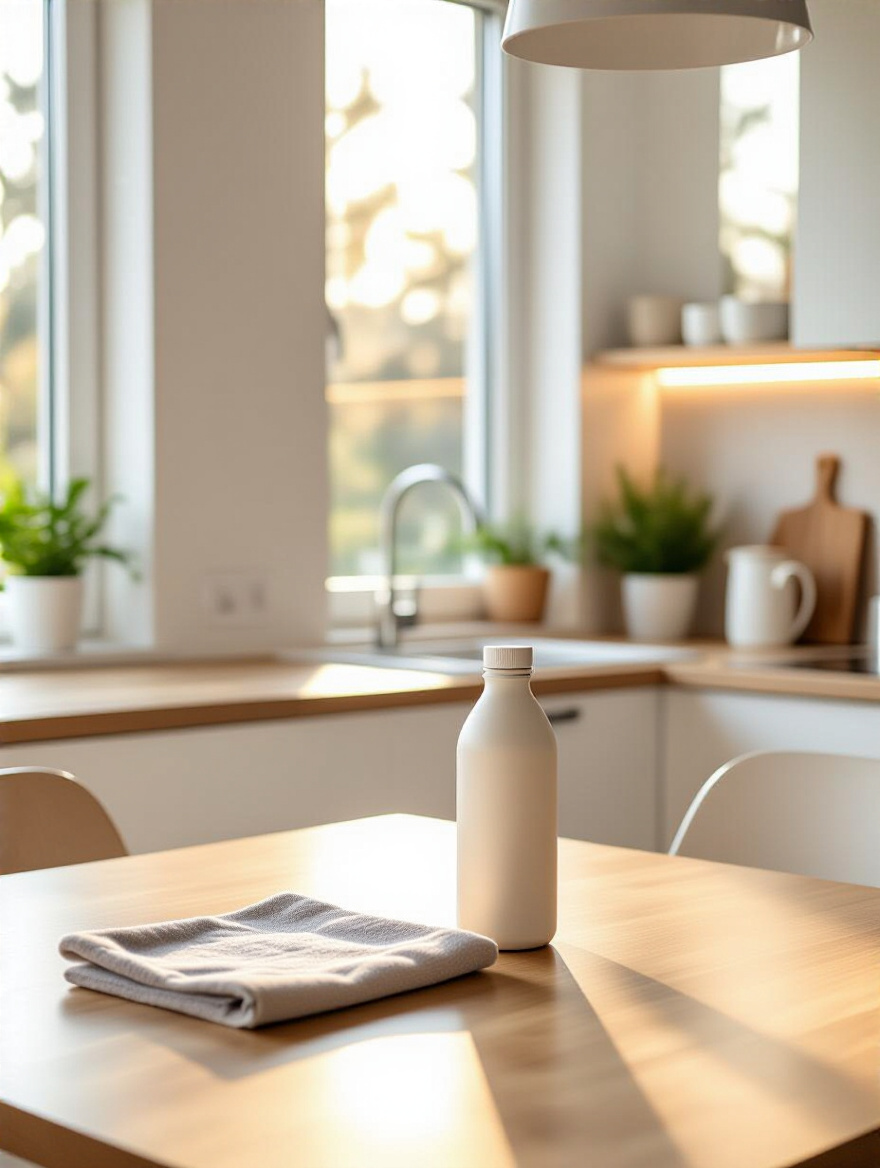
Pay attention to your table’s material. A wood table with an oil finish will need to be re-oiled periodically—maybe once or twice a year—to keep it from drying out and to build up its protective layer. It’s a simple, ten-minute job that fills the kitchen with a wonderful smell and brings the wood’s grain back to life. A lacquered or polyurethane finish is more like a clear coat on a car; it’s tougher but much harder to repair if it gets a deep scratch.
The key is consistency. A quick wipe after every meal prevents food and oils from building up into a sticky, stubborn mess. It’s a two-minute habit that saves you hours of hard scrubbing later and dramatically extends the life of your table’s finish. This isn’t about being fussy; it’s the basic respect the craftsmanship deserves.
Coasters, placemats, and trivets are your table’s best friends. They are the simple, frontline soldiers in the war against damage. A hot dish straight from the oven can leave a permanent white scorch mark on a wood finish in seconds. A sweating glass of iced tea can leave a water ring that will haunt you forever. These simple tools are the easiest and cheapest insurance policy you can have.
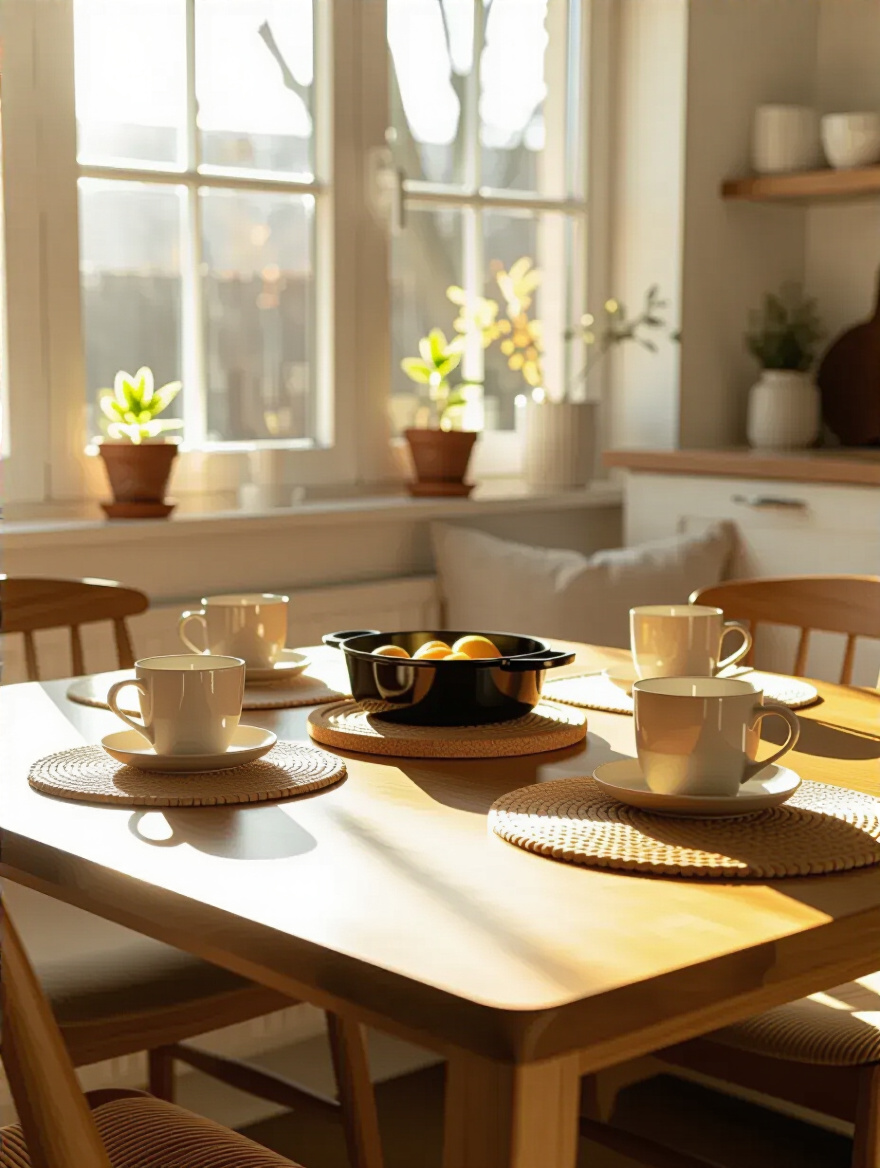
Get everyone in the family in the habit of using them. Keep a stack of coasters in a small dish on the table so they are always within reach. Have a basket of simple, washable placemats handy for meal times. I love cork or felt trivets for hot pots because they are soft, absorbent, and won’t scratch the table themselves. These small habits become second nature quickly.
For pieces you keep on the table long-term, like a vase or a lamp, be sure to put small felt pads on the bottom. This prevents scratches from happening over time as the object is subtly shifted day after day. You’re not trying to keep your table in a museum-like pristine state. You’re simply preventing the kind of careless, deep damage that’s difficult and expensive to fix, allowing it to age naturally and beautifully instead.
Choosing a kitchen table for a home with history is about more than just filling a space. It’s about adding the next chapter to your home’s story. This table will be the silent witness to your family’s life—to hurried breakfasts, lingering holiday dinners, late-night talks, and crayon masterpieces. It deserves to be chosen with intention and care. By focusing on honest materials, timeless design, and a proper fit for your home’s unique architecture, you’re not just buying a piece of furniture; you’re commissioning a future heirloom.
Don’t let the pressure for perfection paralyze you. The goal isn’t to create a flawless museum piece. The goal is to choose a hardworking, beautiful, and authentic table that invites people to gather. The scratches and dings it will inevitably collect are not damage; they are patina. They are the map of a life well-lived. Now is the time to take these ideas and find the piece that speaks to you—the one that feels like it’s finally come home.